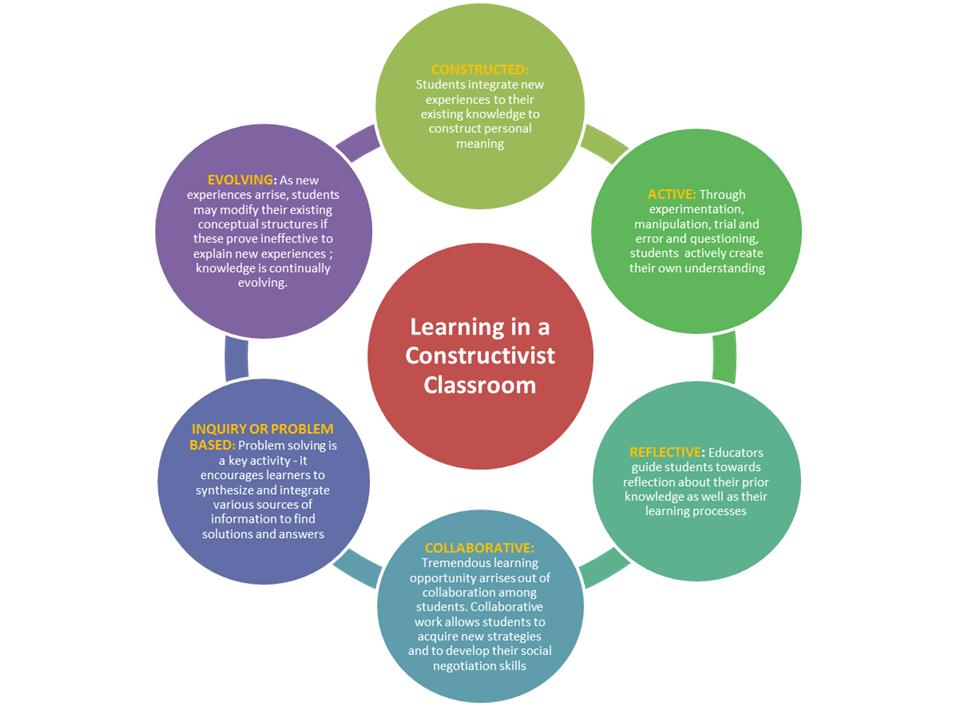Applying Constructivist Theories in the Classroom

“The overarching goals of constructivism are commendable and straightforward: helping students become autonomous learners and thinkers, explore important questions, and build and integrate deeper understandings of knowledge. Of course, the challenge lies not in embracing the theory but in implementing it.”
Learning in a Constructivist Classroom
“Constructivism proposes that learning environments should support multiple perspectives or interpretations of reality, knowledge construction, and context-rich, experience-based activities.” (David H. Jonassen)
In order to create an appropriate learning environment in which knowledge construction can occur, learning in a constructivist classroom should meet the following criteria:

Constructivist Instructional Strategies
Constructivist theory can translate into various instructional approaches. In this section, learn about 5 constructivist pedagogical approaches that are currently receiving significant attention. As you learn more about constructivist instructional approaches and strategies, refer back to the diagram above (Learning in a Constructivist Classroom); does each strategy meet each of the criteria listed?
- Discovery and Inquiry Based Learning
- Based on the constructivist principle that we should “learn by doing”, discovery and inquiry based learning occur whenever the learner is not provided with the exact answer but the materials and resources to find the answers for themselves. They focus on active, hands-on learning opportunities. Although these approaches are very similar, the main difference between discovery learning and inquiry based is that discovery learning confronts the learner to a problem and allows him/her to use their current knowledge to build new knowledge. Inquiry based learning on the other hand is centered around questions where the right question must be asked to promote the development of a deeper understanding.
- Discovery learning is composed of a variety of techniques including Simulation-Based Learning, Learning by Reflection, Learning by exploring/conversing and Incidental Learning.
- Techniques often used in Inquiry based learning include: Fieldwork, Research, Investigation, Problem Based Learning, Individual and Group Work.
- Discovery Learning in Action: Math Consensus with 3rd Graders
- Inquiry Based Learning Example
- Problem Based Learning (PBL)
- The problem based learning page on Wikipedia describes PBL as a “student-centered pedagogy in which students learn about a subject through the experience of problem solving. They learn both thinking strategies and domain knowlege. The goals of PBL are to help the students develop flexible knowledge, effective problem solving skills, self-directed learning, effective collaboration skills and intrinsic motivation. Working in groups, students identify what they already know, what they need to know, and how and where to access new information that may lead to resolution of the problem”
- Examples of Problem Based Learning in University
- Project and Product Based Learning
- Project and product based learning are instructional approaches that encourage the learner, through complex tasks or challenging questions, to create a project or a product. These learning activities are usually long term, interdisciplinary in which groups of learners work relatively autonomously, managing all the tasks related to the projet or creation of a product.
- A project based learning activity about project based learning
- An introduction to Project-Based Learning
- Case Based Learning or the “Case Method”
- Most often used in Adult Education, Case-Based Learning is a popular teaching method in business, medical and law programs. Although the method has been used in Law schools as early as the 1800’s it became largely popular when the Harvard Business school adopted it as a primary teaching method in the early 1900’s.
- The Case-based Learning page of the Center for Instructional Development & Distance Education describes cases as being, “factually-based, complex problems written to stimulate classroom discussion and collaborative analysis. Case teaching involves the interactive, student-centered exploration of realistic and specific situations. As students consider problems from a perspective which requires analysis, they strive to resolve questions that have no single right answer.”
- Teaching with the Case Method at the Harvard Business School
Al dente or well done?
How do you like your constructivist pasta cooked? Share what strategies you currently use with the group by answering the poll below. Please enable the full screen by selecting the button on the bottom right hand side of the poll.
